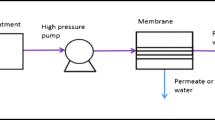Abstract
Surface water samples were collected from the intake, discharge, and heated plume of a fossil-fueled steam electric generating station from January 1974 through September 1976. Dissolved N2 concentrations were determined manometrically for each sample and the percent saturation of each was calculated. Intake N2 levels were near saturation throughout the sampling period while discharge N2 values consistently exceeded saturation, often ranging from 110% to 120% saturation. Saturation levels based on N2 analysis and on polarographic measurement of O2 did not differ significantly. Discharge saturation levels were predictable from a three variable equation which considered the rise in cooling water temperature (ΔT), percent N2 saturation at the intake, and cooling water flow rate. Other parameters associated with cooling system operation were not significantly related to the discharge N2 level. First-order regression analysis indicated that discharge saturation levels could be readily estimated from ΔT measurements. Seasonal variation in supersaturation levels at the discharge was related to the interaction of the ΔT and the intake temperature. Supersaturation occurred throughout the heated effluent; levels decreased with increasing distance from the discharge. Dissipation of supersaturated conditions in the plume resulted from cooling and was predictable.
Similar content being viewed by others
References
Adair, W. D. and Hains, J. J.: 1974, in J. W. Gibbons and R. R. Sharitz (eds.),Thermal Ecology, U.S. AEC Tech. Infor. Cent., Oak Ridge, Tennessee, CONF-730505, p. 59–78.
Bardarik, D. G., Alden, J. C., and Shema, R. L.: 1973,A Study on the Effects of the Operation of a Steam Electric Generating Station on the Aquatic Ecology of Presque Isle Bay, Erie, Pennsylvania, Aquatic Ecology Associates, Inc., Pittsburgh, Pennsylvania.
Committee on Entrainment: 1978, in J. R. Schubel and B. C. Marcy, Jr. (eds.),Power Plant Entrainment: A Biological Assessment, Academic Press, Inc., New York, pp. 1–18.
DeMont, D. J. and Miller, R. W.: 1971, 25th Annual Meeting, Southeastern Association of Game and Fish Commissioners, Charleston, South Carolina, 13 p.
Gloyna, E. F. and Ford, D. L.: 1975, in E. F. Gloyna, H. H. Woodson, and H. R. Drew (eds.),Water Management by the Electric Power Industry VIII, Center for Research on Water Resources, Univ. Texas, Austin, pp. 50–64.
Huston, R. J.: 1975, in E. F. Gloyna, H. H. Woodson, and H. R. Drew (eds.),Water Management by the Electric Power Industry VIII, Center for Research on Water Resources, Univ. Texas, Austin, pp. 40–49.
Lee, G. F. and Martin, P. H.: 1975,Water Res. 9, 643.
Marcello, R. A., Jr. and Fairbanks, R. B.: 1976, in D. H. Fickeisen and M. J. Schneider (eds.),Gas Bubble Disease, U.S. ERDA Tech. Infor. Cent., Oak Ridge, Tennessee, CONF-741033, pp. 75–80.
Miller, R. W.: 1974, in J. W. Gibbons and R. R. Sharitz (eds.),Thermal Ecology, U.S. AEC Tech. Infor. Cent., Oak Ridge, Tennessee, CONF-730505, pp. 79–93.
Otto, R. G.: 1976, in G. W. Esch and R. W. McFarlane (eds.),Thermal Ecology II, U.S. ERDA Tech. Infor. Cent., Oak Ridge, Tennessee, CONF-750425, pp. 121–129.
Pirie, W. R. and Hubert, W. A.: 1977,Trans. Amer. Fish. Soc. 106, 646.
Snedecor, G. W. and Cochran, W. G.: 1967,Statistical Methods, 6th edition, Iowa State Univ. Press, Ames, Iowa, 593 p.
Sokal, R. R. and Rohlf, F. J.: 1969,Biometry, W. R. Freeman & Co., San Francisco, California, 776 p.
Train, R. E., Breidenbach, A. W., Hall, E. P., and Barnes, D.: 1976,Development Document for Best Technology Available for the Location, Design, Construction, and Capacity of Cooling Water Intake Structures for Minimizing Adverse Environmental Impact, U.S. EPA 440/1-76/015-a, 263 p.
Van Slyke, D. D. and Neill, J. M.: 1924,J. Biol. Chem. 61, 523.
Weiss, R. F.: 1970,Deep Sea Res. 17, 721.
Wolke, R. E., Bouck, G. R., and Stroud, R. D.: 1975, in S. B. Saila (ed.),Fisheries and Energy Production: A Symposium, Lexington Books, D. C. Heath & Co., Lexington, Massachusetts, pp. 239–265.
Author information
Authors and Affiliations
Rights and permissions
About this article
Cite this article
Neumann, D.A., Melisky, E.L. & Wachter, W.J. Dissolved nitrogen supersaturation of a heated effluent. Water Air Soil Pollut 22, 1–13 (1984). https://doi.org/10.1007/BF00587460
Received:
Revised:
Issue Date:
DOI: https://doi.org/10.1007/BF00587460




